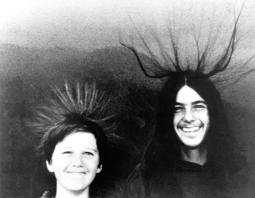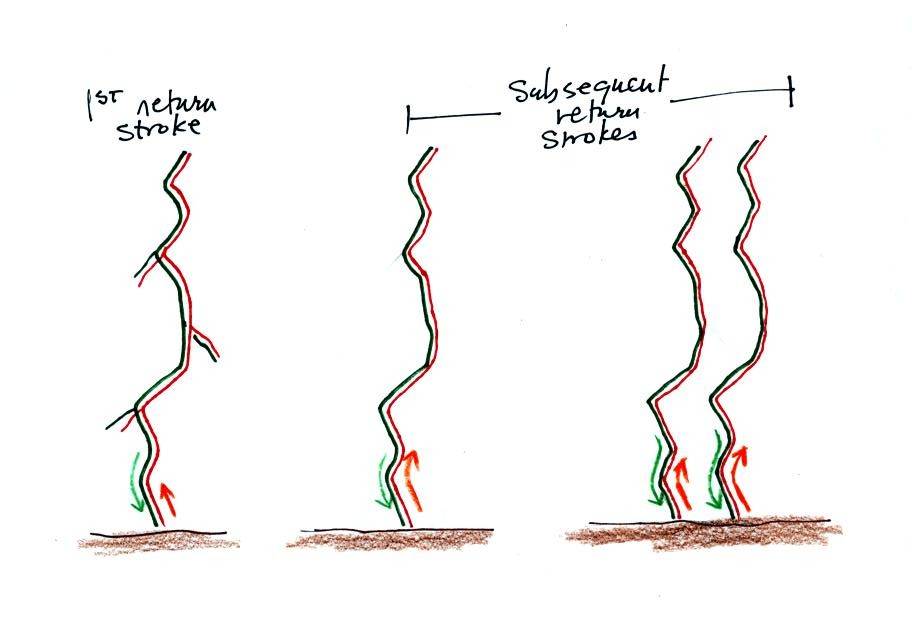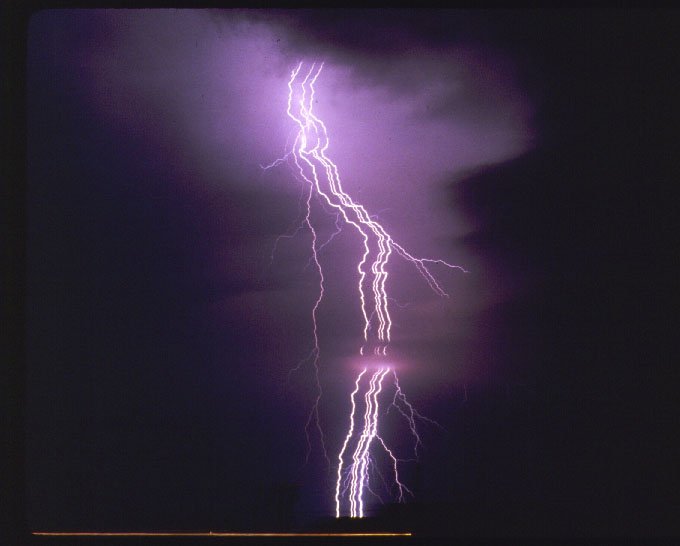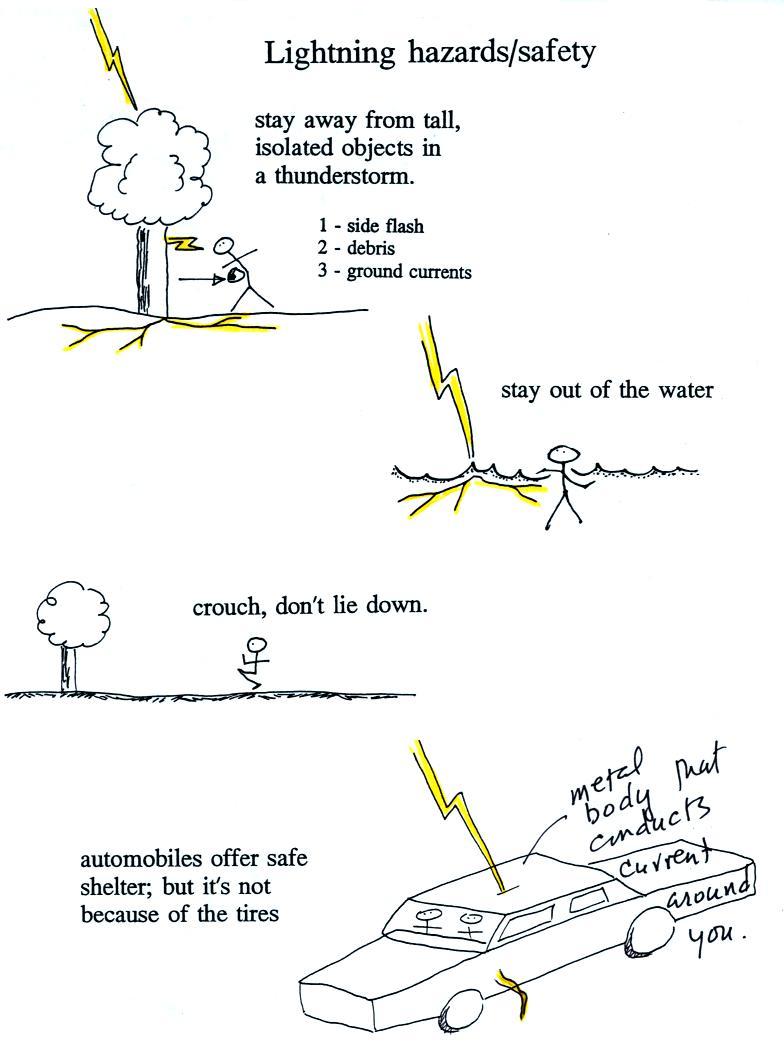 |

|
Cloud to ground lightning with
downward branching (source
of this photo)
|
An upward lightning discharge
initiated by the Eiffel Tower in Paris. The
branching, visible at the top of the photograph, is
upward. Photographed by Hakim Atek, source
of this photo
|
Lightning has also been observed in dust storms and volcanic
eruptions such as in these otherworldly pictures of the 2010
eruption of Eyjafjallajokull
in Iceland. And these more recent
pictures from the Calbuco
volcano in Chile.
A couple of interesting things can happen
at the ground under a thunderstorm. Attraction between
positive charge in the ground and the layer of negative
charge in the cloud can become strong enough that a person's
hair will literally stand on end (see two photos
below). This is incidentally a very dangerous
situation to be in; I wouldn't wait around for my picture to
be taken.
St.
Elmo's Fire (corona discharge) is a faint
electrical discharge that sometimes develops at the tops of
elevated objects during thunderstorms. The link will take you to
a site that shows corona discharge. St. Elmo's fire
was first observed coming from the tall masts of sailing ships
at sea (St. Elmo is the patron saint of sailors). Sailors
in those days were often very superstitious and I suspect they
found St. Elmo's fire pretty terrifying.
3. Cloud to ground lightning - the stepped
leader, upward discharge, and 1st return stroke
A cloud to ground lightning flash is actually a sequence of
several separate events.
Most cloud to ground discharges begin with a
negatively-charged downward-moving stepped leader (the figure
above is on p. 166 in the ClassNotes). A developing
channel makes its way down toward the cloud in 50 m jumps that
occur every 50 millionths of a second or so. Every jump
produces a short flash of light (think of a strobe light dropped
from an airplane that flashes on and off as it falls toward the
ground). The sketch below shows what you'd see if you were
able to photograph the stepped leader on moving film.
Every 50 microseconds or so you'd get a new picture of a
slightly longer channel displaced slightly on the film (the
flash of light would come from the highlighted segments would be
captured on film).
Here's an actual slow motion
movie (video not film) of a stepped leader (its the
second video on the page). The video camera used here
was able to collect 7207 images per second ( a normal video
camera takes 30 images per second). The images were
then replayed at a slower rate. 1/8 of a second of
lightning is stretched out to about 30 seconds on the
video. Here is a larger
collection of slow motion video (a windshield wiper
moves across the image every so often and gives you an idea
of how much the video has been slowed down).
As the leader channel
approaches the ground strong electrical attraction develops
between negative charge in the leader channel and positive
charge on the surface of the ground. Several
positively charged sparks develop and move upward toward the
stepped leader. One of these will intercept the
stepped leader and close the connection between negative
charge in the cloud and positive charge on the ground.

You can see the actual photograph on the
photographers homepage. There were at least 3
upward discharges initiated by the approach of the stepped
leader (1, 2, and 3 in the sketch). Streamer 1
connected to the bottom of the stepped leader. It
isn't clear where the exact junction point was, perhaps at
the point where the channel bends indicated with the red
arrow. The downward branching at Point 4 indicates
that was part of the descending stepped leader. A
very faint upward discharge can be seen at Point 3.
Here's another
more recent photograph (click on Galleries on the
bar near the top of the page, then click on Lightning
Gallery 1). We'll learn later in the class that a
lightning flash often consists of several strikes to the
ground that occur in less than 1 second. You can
clearly see separate ground strikes in this photo.
4. Lightning rods
Lightning rods (invented by Benjamin Franklin) make use of
the upward connecting discharge.

Houses with and without lightning
rods are shown above. When lightning strikes
the house without a lightning rod at left the
powerful return stroke travels into the house
destroying the TV and possibly starting the house on
fire. With a
lightning rod, an upward discharge launched off the
top of the lightning rod intercepts the stepped
leader and safely carries the lightning current
through a thick wire around the house and into the
ground. Lightning rods do work
and they have changed little since their initial
development in the 1700s. Most of
the newer buildings on campus are protected
with lightning rods. If you look
carefully at the roof of Old Main, which was
recently remodeled, you'll see lightning rods.
The connection between the stepped leader and
the upward discharge creates a "short circuit" between
the charge in the cloud and the charge in the ground.

A powerful
current travels back up the channel from the ground
toward the cloud. This is the 1st return
stroke. Large currents (typically 30,000
amps in this 1st return stroke) heat the air to
around 30,000K (5 times hotter than the surface of
the sun which is 6000 K) which causes the air to
explode. When you hear thunder, you are
hearing the sound produced by this explosion.
The figure below summarizes what we've
covered so far in simplified form

Does lightning travel upward
or downward? The answer is it does both. It starts
with a downward leader than is followed by an upward moving
return stroke.
Many cloud-to-ground flashes end at this point. In
about 50% of cloud to ground discharges, the stepped
leader-upward discharge-return stroke sequence repeats itself
(multiple times) with a few subtle differences. That's
covered below.
5. Multiple strokes flashes - dart leaders and
subsequent return strokes
A downward dart leader
travels from the cloud to the ground. The dart leader
doesn't step but travels smoothly and follows the channel
created by the stepped leader (avoiding the branches).
It is followed by a slightly less powerful subsequent return
stroke that travels back up the channel to the cloud.
This second stroke might be followed by a third, a fourth,
and so on. The subsequent return stroke channel
usually doesn't have branches.

Here's a stepped leader-upward
connecting discharge-return stroke animation
(you'll see the stepped leader, upward discharges, and
the first return stroke. Two additional subsequent
strokes are shown without the dart leader).
The sketch above and the photo below show a multiple stroke
flash consisting of 4 separate return strokes. There is enough
time between separate return strokes (around 1/20th to 1/10th of
a second) that your eye can separate the individual flashes of
light. Separate return strokes cause the flickering you
sometimes see when looking at lightning.
6. Positive lightning
We've been looking at strikes that originate in the
negative charge center is a thunderstorm (discharge at left in
figure above). Occasionally a lightning
stroke will travel from the positive charge region in the top
of the thunderstorm cloud to ground (shown at right in the
figure above). These types of strikes are more common at
the ends of storms and in winter storms.
This is probably because the top part of the cloud gets pushed
sideways away from the middle and bottom portions of the
cloud. Positive strokes are very powerful. They
sometimes produce an unusually loud and long lasting clap of
thunder.
7. Upward lightning
Here's an even rarer form of lightning. Lightning
sometimes starts at the ground and travels upward. Upward
lightning is generally only initiated by mountains and tall
objects such as a skyscraper or a tower of some kind (the Empire
State Building is struck many times every year but lightning and
usually it's lightning that the building itself caused).
Note the discharge is different in another way also.
These discharges are initiated by an upward leader. This
is not followed by a return stroke, like you might expect, but
by a more normal downward leader. Once the 2nd leader
reaches the ground, an upward return stroke travels back up the
channel to the cloud.
8. Rocket triggered lightning

The fact that lightning could
begin with an upward discharge that begins at the ground led
(French) scientists to develop a technique to trigger
lightning by firing a small rocket up toward a
thunderstorm. The rocket is connected by a thin wire to
the ground. When the rocket gets 50 to 100 m above the
ground an upward streamer will develop off of the top of the
wire. Once the streamer reaches the cloud it can
initiate a "normal" series of downward dart leaders and upward
subsequent return strokes.

|

|
Photograph of a triggered lightning
discharge taken from a few 100 meters away. The
straight part of the channel is where the discharge
followed the wire. The lightning channel becomes
much more jagged when traveling through air above the
wire. (source
of this photo)
|
A closeup of triggered lightning
striking the launch tower. The green portion of
the image at left is produced by heating and
vaporization of the wire used to trigger the
discharge. The brighter whiter strokes of
lightning are seen at right. They have been
spread across the picture by wind. Photo credit:
Doug Jordan and Martin Uman International Center for
Lightning Research and Testing
|
Scientists are able to take closeup photographs and make
measurements of lightning currents using triggered
lightning. Triggered lightning can also be used to test
the operation of lightning protection devices.
Here's a link
to the video that was showed in class.
The abbreviation NLDN that you'll see at the start of the
video stands for National
Lightning Detection Network. The headquarters of
this company is located here in Tucson.
In the first 1:30 of the video you'll see natural lightning
occurring in the Tucson area during the summer (both intracloud
and cloud to ground discharges). Look for the
flickering that means multiple return strokes in a flash.
Between 1:30 and about 2:00 you'll see lightning activity
photographed at the Grand Canyon. Lightning at the Grand
Canyon preferentially strikes the edges of the canyon, a
location to avoid if you're there during a thunderstorm.
The first 2 minutes of the video
wasn't shown in class.
Next, between about 2:00 and 2:40 photographs of lightning
striking large wind turbines in Kansas. A lightning strike
to one of the turbine blades can cause damage that is very
expensive to repair. At 2:16 and again at about 2:24
you'll see very bright lightning flashes that momentarily
overexpose the video. These were probably positive cloud
to ground discharges. And look carefully at the discharge
that occurs between about 2:28 and 2:31 on the video.
Notice the upward pointing branching. This was an upward
discharge initiated by one of the wind turbines.
Starting about 2:50 and for the remainder of the video you'll
see some rocket triggered lightning. These experiments
were done at the International Center for Lightning Research and
Testing (ICLRT) run by the University of Florida near
Gainesville, FL.
A student in a previous class asked a question, after
the video, about what causes the green color that is sometimes
seen in photographs of triggered lightning. The answer
that is probably from vaporization of the copper wire that is
carried upward by the rocket. If you're someone that
enjoys watching lightning storms you may remember having seen a
green glow when lightning strikes the ground. This is
often produced by an exploding transformer on an electric power
pole. The copper wire in the transformer is vaporized by
the lightning.
The vaporization of different chemical compounds is what gives
fireworks their distinctive colors. This
link lists some of the chemical compounds and the colors
they produce.
9. Fulgurites
When lightning strikes the ground it will often melt the soil
(especially sandy soil) and leave behind a rootlike structure
called a fulgurite. A fulgurite is just a narrow (1/2 to 1
inch across) segment of melted sand (glass). The
photographs of fulgurites above were found at the University of Florida
lightning triggering site.
10. Lightning safety
Lightning is a serious weather hazard. Here are some
lightning safety rules that you should keep in mind during
thundery weather.
Stay
away
from
tall
isolated
objects
during
a
lightning
storm.
You
can
be
hurt
or
killed
just
by
being
close
to
a
lightning
strike
even
if
you're
not
struck
directly.
Lightning currents often travel outward along
the surface of the ground (or in water) rather
than going straight down into the
ground. Just being close to something
struck by lightning puts you at risk. When
you hear of someone being struck by lightning
and living to tell about it, it was often a
nearby rather than a direct strike.
An
automobile with a metal roof and body provides
good protection from lightning. Many people
think this is because the tires insulate the car
from the ground. But the real reason cars
are safe is that the lightning current will travel
through the metal and around the passengers
inside. The rubber tires really don't play
any role at all. The people in Florida in
the video that were triggering lightning with
rockets were inside a metal trailer and were
perfectly safe. All of the connections made
to equipment outside the trailer were done using
fiber optics, there were no metal wires entering
or leaving the trailer.
You shouldn't use
a corded phone or electrical appliances during a
lightning storm because lightning currents can
follow wires into your home. Cordless phones
and cell phones are safe. It is also a good
idea to stay away from plumbing as much as possible
(don't take a shower during a lightning storm, for
example). Vent pipes are connected to the
plumbing and go up to the roof of the house which
puts them in a perfect location to be struck by
lightning.
To estimate the distance
to a lightning strike count the number of seconds
between the flash of light and when you first hear the
thunder. Divide this by 5 to get the distance in
miles.

The latest lightning safety recommendation
is the 30/30 Rule.
The 30/30 rule
People should seek shelter if the delay between a lightning
flash and its thunder is 30
seconds or less
(the lightning is within 6 miles).
People should remain under cover until 30 minutes after the final
clap of thunder. The powerful positive
strokes often occur at the ends of thunderstorms.

























